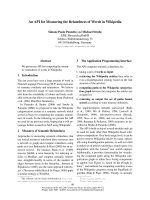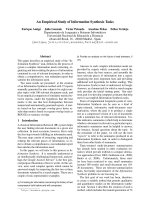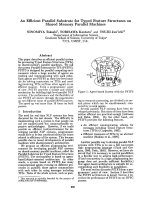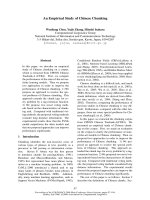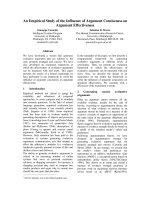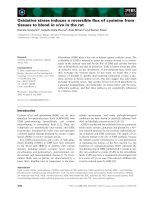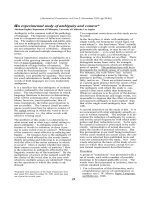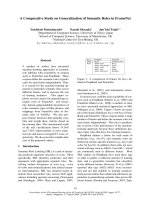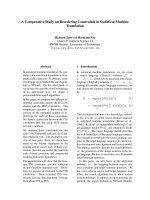Báo cáo khoa học: "An ultrastructural study on cytotoxic effects of mono(2-ethylhexyl) phthalate (MEHP) on testes in Shiba goat in vitro" pptx
Bạn đang xem bản rút gọn của tài liệu. Xem và tải ngay bản đầy đủ của tài liệu tại đây (6.91 MB, 6 trang )
-2851$/ 2)
9H W H U L Q D U \
6FLHQFH
J. Vet. Sci.
(2004),
/
5
(3), 235–240
An ultrastructural study on cytotoxic effects of mono(2-ethylhexyl)
phthalate (MEHP) on testes in Shiba goat
in vitro
Bibin Bintang Andriana
1, 3,
*, Tat Wei Tay
1
, Ishii Maki
1
, Mohammad Abdul Awal
1
, Yoshiakira Kanai
1
,
Masamichi Kurohmaru
1
, Yoshihiro Hayashi
2
1
Department of Veterinary Anatomy, Graduate School of Agricultural and Life Sciences, The University of Tokyo,
Tokyo 113-865, Japan
2
Department of Global Animal Resource Science, Graduate School of Agricultural and Life Sciences, The University of Tokyo,
Tokyo 113-865, Japan
3
Faculty of Animal Husbandry, Bogor Agriculture University, Kampus Darmaga, Bogor 16680, Indonesia
In this study, the effects of mono(2-ethylhexyl) phthalate
(MEHP), one of metabolites of di(2-ethylhexyl) phthalate, on
immature Shiba goat testes in vitro were examined. The
testes of 2-month-old Shiba goats were cut into smaller
pieces, and seeded in medium. At 1, 3, 6 and 9 hr after
administration of MEHP at various concentrations (0,
100 nmol · ml
−
1
, 1 nmol · ml
−
1
, and 1
×
10
−
3
nmol · ml
−
1
,
respectively), the specimens were obtained for light and
transmission electron microscopic observations. As a result,
at 1 hr after exposure to MEHP, the vacuolization and
nuclear membrane rupture appeared in Sertoli cells. Such
alterations tended to gradually increase in number in time-
and dose-dependent manners. Moreover, by MEHP
treatment, apoptotic spermatogenic cells (characterized with
chromatin condensation, cytoplasm shrinkage without
membrane rupture, still functioning cell organelles, and
packed cell contents in membrane-bounded bodies),
apoptotic Sertoli cells (characterized with nuclear
membrane lysis, nuclear condensation), necrotic
spermatogenic cells (characterized with swollen and
ruptured mitochondria, plasma membrane lysis, spilt cell
contents, and chromatin clumps), and necrotic Sertoli cells
(characterized with marginated chromatins along the
nuclear membrane, ruptured vesicles within the MNB, some
swollen and ruptured cell organelles, e.g. mitochondria)
could be identified. Conclusively, ultrastructurally the
treatment with MEHP at low concentration tends to lead
spermatogenic and Sertoli cells to apoptosis, whereas that at
high concentration tends to lead spermatogenic and Sertoli
cells to necrosis. Thus, the testicular tissue culture is
advantageous for screening testicular toxicity of chemicals.
Key words:
Sertoli cell, mono(2-ethylhexyl) phthalate (MEHP)
Introduction
Plastic is one of customer products, and has a contribution
to be an environmental pollutant. At first, plastic is brisket
goods. Due to addition of phthalate as a plastic softener, it
becomes flexible, durable and comfortable to be used for
human life. For example; phthalic acid esters have been
widely used as plasticizers in biomedical apparatus and food
or beverage packaging [16], including building materials,
food packaging, clothing, toys, childrenís product, blood
bags, intravenous fluid bags and infusion sets, and other
medical devices [8]. They are also used in solvents,
lubricating oils, fixatives, detergents, and products such as
cosmetics and wood finishes [19]. The authors above
mentioned also have informed that phthalates do not
covalently bind to the plastic matrix, and leach out from
polyvinyl chloride (PVC) when they come in contact with
lipophilic substances, and that they are released directly into
the environment during production and use, and after
disposal of PVC and other phthalate-containing products.
Thus, phthalates are ubiquitous contaminants in food, indoor
air, soils, and sediments [22]. Many kinds of phthalates [13]
are present, for example, dimethyl phthalate (DMP), diethyl
phthalate (DEP), dibutyl phthalate (DBP), benzylbutyl
phthalate (BBP), diethylhexyl phthalate (DEHP), and
dioctyl phthalate (DOP), and so on.
Phthalic acid ester has already been proved as a potential
compound to reduce fertility and induce testicular atrophy in
laboratory animals [23]. One of the most widely-studied
male reproductive toxicants in rats is di(2-ethylhexyl)
phthalate (DEHP) [16]. It has been reported that after oral
administration, phthalates were rapidly hydrolyzed in gut
and other tissues by nonspecific esterases to produce the
corresponding monoester [1,17,11,23]. And other researchers
[20] have reported that in intestine, DEHP is rapidly
absorbed, primarily in the form of monoester, mono(2-
*Corresponding author
Tel: +81-3-5841-5384 Fax: +81-3-5841-8181
E-mail:
236 Bibin Bintang Andriana
et al.
ethylhexyl) phthalate, which results from hydrolysis of the
parent compound by gut lipases. It has been also reported
that one of the most potent monoester as an ultimate
testicular toxic metabolite is mono(2-ethylhexyl) phthalate
(MEHP) [14]. The initial metabolism of DEHP to MEHP is
qualitatively similar among mammalian species [11,15],
though hydrolysis is more effective in rodents than in higher
mammals and humans [9 is cited in 24]. Thus, MEHP is
thought to be responsible for compound toxicity [11,12].
On the effects of endocrine disruptors, most of the
researches have been carried out in rodents such as rats,
mice, and hamsters. Therefore, the present study dealed with
Shiba goats (Order Artiodactyla). The study has one goal; it
is to examine whether the Shiba goat testicular tissue culture
are useful for endrocrine disruptor risk assessment.
Moreover, since the
in vitro
study on this area is quite few,
the testicular tissue culture derived from immature Shiba
goat testes were used for MEHP risk assessment. Thus,
biochemical effects of MEHP on Sertoli and spermatogenic
cells in immature Shiba goats were examined by light and
transmission electron microscopy.
Materials and Methods
Animals and Chemicals
MEHP was dissolved in dimethyl sulfoxide (DMSO). The
2-month-old Shiba goats were obtained from the stock farm,
the University of Tokyo, Ibaraki, Japan. Nucleopore filters,
approximately 10 mm in diameter (pore size = 3 µm in
diameter) were from Whatman (Clifton, NJ, USA),
Dulbecco’s Minimum Essential Medium (DMEM) from
WAKO (Japan), antibiotics (penicillin, streptomycin).
Testicular tissue culture
Under chloroform anesthesia, the animals were sacrificed,
and the testes were surgically excised. They were decapsulated,
and cut into smaller pieces (approximately 1 mm
3
in
volume) for testicular tissue culture.
After washing three times with DMEM, testicular tissues
were immediately placed on nucleopore filter, and floated
on medium. The medium was composed of DMEM,
antibiotics (200-unit penicillin 100 IU/ml and streptomycin
100 g/ml), added DMSO, and ethanol for concentration
adjustment. The experimental group was administrated with
MEHP at the concentration of 100, 1, and 1
×
10
−
3
nmol · ml
−
1
,
respectively. The tissue culture was incubated at 32
o
C in a
humidified atmosphere consisting of 95% air and 5% CO
2
.
The first harvesting was carried out at 1 hr. Then, the
harvesting was done at 3, 6, and 9 hr.
The harvested-testicular tissue cultures were immediately
washed with PBS, fixed in 2.5% glutaraldehyde-0.05 M
cacodylate buffer (pH 7.4) at 4
o
C for 2 hr. Then, they were
washed 3 times with the same buffer, postfixed in 1% OsO
4
for 2 hr, dehydrated through a graded series of ethanol (50,
70, 80, 90, 95 and 100% ethanol), and embedded in
Araldite-M. Semithin sections of 1
µ
m were stained with
0.5% toluidine blue for light microscopy. Ultrathin sections
were stained with uranyl acetate and lead citrate, and
examined in a JEM-1200 EX transmission electron
microscope at 60 kV.
Results
In this study, immature Shiba goats (2-month-old) were
chosen as an animal model, and sacrificed for the evaluation
of the effects of MEHP on the testicular tissue culture. The
treatment by MEHP caused the morphological alterations in
Sertoli and spermatogenic cells.
Light microscopy (Fig. 1)
The increase of MEHP concentration has a strong
correlation with the increase of degenerated (apoptotic and/
or necrotic) Sertoli and spermatogenic cells. From 3 to 9 hr,
F
ig. 1. Light micrographs of testicular tissue culture stained wi
th
0
.5% toluidine blue. (a) Control, (b) MEHP-treated (1 nmol
·
ml
−1
).
V
acuolization (#) and degenerated cells (arrow) can be identifi
ed
(
magnification 5
×
100). Arrowhead indicates a visible vesicle
of
m
ultivesicular nuclear body.
F
ig. 2. Transmission electron micrograph showing seminifero
us
t
ubule of testicular tissue culture from 2-month-old Shiba go
at.
S
ertoli cells dominate a seminiferous tubule. (Control).
Effects of MEHP on Shiba goat testes
in vitro
237
at each concentration, vacuolization and sloughing of
spermatogenic cells could be visible. At highest concentration
of MEHP, vacuolization was found even within nucleoplasm.
At the light microscopic level, however, the destruction of
nuclear membrane and the alteration of cell organelles could
not be identified.
Transmission electron microscopy
By transmission electron microscopy, degenerated cells
could be categorized into necrotic and apoptotic cells. Fig. 2
showed the appearance of the seminiferous tubule in the
control group at low magnification. Sertoli cells, situated on
the basal lamina, dominated the seminiferous tubule.
Ultrastructurally, though infrequently encountered, the
distention of mitochondria in testicular tissue cultures was
apparent at 1 hr after MEHP administration (Figure not
shown). After MEHP administration (1 nmol · ml
−
1
, 1 hr),
abnormal vesicles within the nucleus and ruptured
mitochondria membrane were recognized (Fig. 3).
At 3 hr after MEHP treatment, abnormal vesicles, varied
in appearance, were frequently encountered (Fig. 4).
Vacuolization was also frequently found at this duration
(Fig. 5). Damaged spermatogonia were also recognized, as
depicted in Fig. 6. Abnormal nucleoplasm and disrupted
mitochondria were seen within spermatogonia. The Sertoli
cells with abnormal vesicles within the nucleus should
correspond to necrotic cells. The number of necrotic cells
tended to gradually increase in amount in a time-dependent
manner.
MEHP treatment (1 nmol · ml
−
1
) for 6 hr caused apoptotic
spermatogonia. Vacuolization and swollen mitochondria
within the cytoplasm were frequently recognized (Fig. 7).
In Sertoli cells, MEHP treatment (1
×
10
−
3
nmol · ml
−
1
) for
6 hr showed the more advanced alterations. Some
F
ig. 3.
Ultrastructural appearance of necrotic Sertoli cell
in
M
EHP-treated (1 nmol
·
ml
−1
) testicular tissue culture at 1
hr
a
fter treatment. (a) Low magnification. (b) Higher magnificatio
n.
A
large vesicle (arrowhead) is visible, and a ruptured membra
ne
o
f mitochondria (black arrow) is also identified. It should be t
he
f
irst step of necrosis.
F
ig. 4.
Transmission electron micrographs showing Sertoli c
ell
n
ucleus of testicular tissue culture from 2-month-old Shiba go
at.
(
a) Control and (b) Necrotic Sertoli cell, after 1 nmol
·
m
l
−
1
M
EHP for 1 hr. Some vesicles of MNB seem to alter the
ir
s
tructure (arrow).
F
ig. 5.
Transmission electron micrograph showing t
he
d
egenerated Sertoli cell. The nucleus contains an abnorm
al
v
esicle (arrow) and has some marginal chromatins along t
he
n
uclear membrane. Mitochondria distention (*) a
nd
v
acuolization (#) are also visible. Treated with 1 nmol
·
ml
−1
of
M
EHP for 3 hr.
F
ig. 6.
Transmission electron micrographs showing t
he
d
egenerated spermatogonia at early stage. (a) Control. (
b)
S
permatogonia reveal an abnormal appearance (circle). Treat
ed
w
ith 1 nmol
·
ml
−1
of MEHP for 3 hr.
238 Bibin Bintang Andriana
et al.
marginated chromatins along the nuclear membrane were
observed (Fig. 8). It could be understood the morphological
differences among normal, apoptotic, and necrotic Sertoli
cells of testicular tissue cultures. Necrotic Sertoli cells were
also recognized by MEHP treatment (1
×
10
−
3
nmol · ml
−
1
)
for 6 hr.
Fig. 9 revealed the appearances of Sertoli cells after
MEHP treatment (100 nmol · ml
−
1
) for 6 hr and/or 9 hr. In
9 hr treatment, more advanced alterations of necrotic Sertoli
cell nuclei could be recognized. Vacuolization, ruptured
mitochondria and abnormal chromatin along the nuclear
membrane were frequently encountered. In Fig. 10, the
alterations of Sertoli and spermatogenic cells could be seen.
Ultrastructurally, the morphological alterations of Sertoli
and spermatogenic cells could be described as follows;
Apoptotic spermatogenic cells showed the chromatin
condensation, cytoplasm shrinkage without membrane
rupture, nuclear membrane rupture, still functioning cell
organelles, and packed cell contents in membrane-bounded
bodies. Necrotic spermatogenic cells revealed swollen and
ruptured mitochondria, plasma membrane lysis,
vacuolization within cytoplasm, and chromatin clumps.
Apoptotic Sertoli cells were characterized with nuclear
membrane lysis, nuclear condensation. Necrotic Sertoli cells
showed marginated chromatins along the nuclear
membrane, ruptured vesicles within the MNB, and some
swollen and ruptured cell organelles, e.g. mitochondria.
Discussion
In this study, the
in vitro
model (testicular tissue culture)
was adopted in order to examine the effects of MEHP on
Shiba goat testes. As a result, even a low concentration of
MEHP caused permanent changes in testicular tissue
cultures from immature Shiba goats. The result has a well
coincidence with several reports, óMEHP at low
concentration also affected co-cultured Sertoli cells from
neonatal rats [12].
Although the
in vitro
model of immature Shiba goat testes
was sensitive to the treatment, no quantitative data were
obtained. Therefore, the results could not be compared with
those of prepubertal rats on this point. It has been reported
that prepurbertal Sprague Dawley rats were more sensitive
to the reproductive effects of phthalate esters [5,21]. And
those young rats were also more sensitive to phthalate esters
due to the differences in absorption, distribution, and
metabolism between young and old rats [7,21].
In this study, it seems likely that the morphological
alterations of Sertoli cells appear first, and then
spermatogenic cells were damaged due to injured Sertoli
F
ig. 7. Transmission electron micrographs showing a membra
ne
l
ysis in spermatogonia after treatment with 1 nmol
·
ml
−1
of
M
EHP for 6 hr. (a) Apoptotic spermatogonia at low
er
m
agnification. Vacuolization is visible (#). (b) At high
er
m
agnification, nearly 50% of nuclear membrane
in
s
permatogonia is damaged (arrows).
F
ig. 8. Transmission electron micrographs showing the testicul
ar
t
issue culture. Sertoli cell nucleus after MEHP-treatment (1
×
1
0
−
3
n
mol
·
ml
−1
) for 6 hr. Abnormality of the nucleus can be see
n.
S
ome chromatins along the nuclear membrane (arrows) revea
ls
a
bnormal in appearance.
F
ig. 9. Transmission electron micrographs showing necro
tic
S
ertoli cells. Necrotic Sertoli cell after treatment with 1
00
n
mol
·
ml
−1
MEHP for 6 hr (a) and 9 hr (b). Abnormality of c
ell
o
rganelles can be seen [ruptured mitochondria membrane (bla
ck
a
rrows), vacuolization, abnormal chromatins along the nucle
ar
m
embrane].
Effects of MEHP on Shiba goat testes
in vitro
239
cells. This finding is in well agreement with the report that
the primary target cell in the testis is the Sertoli cell [2], and
the increased detachment of spermatogenic cells is derived
from Sertoli cell alterations by MEHP [12].
After administration of MEHP, Sertoli cells revealed some
morphological alterations. Necrotic Sertoli cells characterized
with plasma membrane rupture, marginated chromatin
along nuclear membrane, swollen mitochondria and
nucleus, and vacuolization within cytoplasm were detected.
Apoptotic Sertoli cells characterized with ruptured nucleus,
shrinkage of cytoplasm and nucleus, and still functioning
cell organelles were also recognized. These morphological
alterations were commonly observed in other animal models
of toxic experiments [10]. Those findings are also well
consistent with the report that MEHP causes the rapid
Sertoli cell vacuolization [3]. And those in common
pathologic findings, Sertoli nuclei frequently showed a
slight margination of chromatin, especially at the electron
microscope level [18]. The peculiar morphological change
obtained in this study was the alteration of vesicles. The
alteration of vesicles induced by MEHP was the common
result in this experiment.
Particularly in Shiba goat testes, one considerable matter
is the presence of multivesicular nuclear body (MNB) that
appears for the first time at 2-month-old. The MNB also has
a potential as an indicator of MEHP-treatment effect.
Ultrastructurally, there were some differences in alterations
between Sertoli and spermatogenic cells. In the MEHP
treatment for 1 hr, Sertoli cells just responded at the
concentration of 1 nmol · ml
−
1
MEHP for 1 hr (Fig. 3).
While, in spermatogenic cells, the MEHP treatment caused
the ruptured nuclear membrane at the concentration of
1nmol·ml
−
1
for 6 hr (Fig. 7).
Although Sertoli cells have been examined as the target of
the phthalate esters toxic study [6], the mechanism of the
Sertoli cell alteration by phthalate esters is still unclear. The
same authors have indicated that the mechanism of phthalate
esters toxicity may relate to the Sertoli cell cAMP second
messenger system. The cAMP is sensitive to phthalate
esters. And it has been also suggested that phthalate esters
inhibit the FSH-stimulated elevation of extracellular cAMP
in cultured Sertoli cells [4].
Acknowledgments
The skilful technical assistance of Mr. I. Tsugiyama
(Department of veterinary Anatomy, The University of
Tokyo) is gratefully acknowledged. This work was
supported in part by Grants-in-Aid from the Ministry of
Health, Labour and Welfare, Japan.
References
1. Albro PW, Thomas R, Fishbein L. Metabolism of
diethylhexylphthalate in rats, isolation and characterization
of the urinary metabolites. J Chromato 1973, 76, 321-330.
2. Boekelheide K. Sertoli cell toxicants. In: Russell LD,
Griswold M (eds.). The Sertoli Cell. pp. 551-575. Cache
River Press, Clearwater, 1993.
3. Creasy DM, Beech LM, Gray TJ, Dutton SL, Butler WH.
The ultrastructural effects of di-n-pentyl phthalate on the
testis of the mature rat. Exp Mol Pathol 1987, 46, 357-371.
4. Foster P. Assessing the effects of chemicals on male
reproductions: lessons learned from di-n-butyl phthalate.
CIIT Activities 1997, 17, No 9.
5. Gray TJB, Butterworth KR. Testicular atrophy produced
by phthalate esters. Arch Toxicol Suppl. 1980, 4, 452-455.
6. Heindel JJ, Chapin RE. Inhibition of FSH-stimulated camp
accumulation by mono(2-ethylhexyl) phthalate in primary rat
Sertoli cell cultures. Toxicol Appl Pharmacol 1989, 97, 377-
385.
7. Heindel JJ, Powell CJ. Phthalate ester effects on rat Sertoli
cell function
in vitro
: Effect of phthalate side chain and age of
animal. Toxicol Appl Pharmacol 1992, 115, 116-123.
8. Huber WW, Grasl-Kraupp B, Schulte-Hermann R.
Hepatocarcinogenic potential of di(2-ethylhexyl)phthalate in
F
ig. 10. Transmission electron micrographs showing necro
tic
S
ertoli and spermatogenic cells, and apoptotic spermatogen
ic
c
ells (red arrow) at low magnification. (a) Control, (b) 1
×
10
−
3
n
mol
·
ml
−1
MEHP, (c) 1 nmol
·
ml
−1
MEHP. Cultured for 6
hr
e
ach.
240 Bibin Bintang Andriana
et al.
rodents and its implications on human risk. Crit Rev Toxicol
1996,
26
, 365-481.
9.
KemI (Swedish National Chemical Inspectorate).
Risk
assessment for di(2-ethylhexyl)phthalate. Stockholm. 1998,
Draft Document, Sept. EINECS-NO: 240-211-0.
10.
Kerr JF, Wyllie HA, Currie AR.
Apoptosis: a basic
biological phenomenon with wide-ranging implications in
tissue kinetics. Br J Cancer 1972,
26
, 239-257.
11.
Lake BG, Phillips JC, Linnell JC, Gangolli SD.
The
in
vitro
hydrolysis of some phthalate diester by hepatic and
intestinal preparations from various species. Tocicol Appl
Pharmacol 1977,
39
, 239-248.
12.
Li L, Jester W, Orth J.
Effects of relatively low levels of
mono-(2-ethylhexyl) phthalate on cocultured Sertoli cells and
gonocytes from neonatal rats. Toxicol Appl Pharmacol 1998,
152
, 258-265.
13.
Mihovec-Grdic M, Smit Z, Puntaric D, Bosnir J.
Phthalates in underground waters of the zagreb area. Croat
Med J 2002,
43
, 493-497.
14.
Pollack GM, Li RC, Ermer JC, Shen DD.
Effects of route
of administration and repetitive dosing on the disposition
kinetics of di(2-ethylhexyl) phthalate and its mono-de-
esterified metabolite in rats. Toxicol Appl Pharmacol 1985,
79
, 246-256.
15.
Rhodes C, Orton T, Pratt I, Batten P, Bratt H, Jackson S,
Elcombe C.
Comparative pharmacokinetics and subacute
toxicity of di(2-ethylhexyl) phthalate (DEHP) in rats and
marmosets: extrapolation of effects in rodents to man.
Environ Heatlh Perspect 1986,
65
, 299-308.
16.
Richburg JH, Boekelheide K.
Mono(2-ethylhexyl)
phthalate rapidly alters both Sertoli cell vimentin filaments
and germ cell apoptosis in young rat testes. Toxicol Appl
Pharmacol 1996,
137
, 42-50.
17.
Rowland IR, Contrel RC, Phillips JC.
Hydrolysis of
phthalate ester by the gastro-intestinal contents of the rat.
Food Cosmet Toxicol 1977,
15
, 17-21.
18.
Russell LD, Gardner PJ.
Testiscular ultrastructure and
fertility in the restricted color (H-re) rat. Biol Reprod 1974,
11
, 631-643.
19.
Shea, K. M. and The Committee on Environmental
Health.
Pediatric exposure and potential toxicity of phthalate
plasticizers. Pediatrics 2003,
111
,1467-1471.
20.
Sjöberg P, Bondesson U, Sedin E, Gustafsson J.
Disposition of di- and mono-(2-ethylhexyl) phthalate in
newborn infant subjected to exchange transfusions. Eur J
Clin Invest 1985,
15
, 430-436.
21.
Sjöberg P, Bondesson U, Gray TGB, Plöen L.
Effects of
di(2-ethylhexyl) phthalate and five of its metabolites on rat
testes
in vivo
and
in vitro
. Acta Pharmacol Toxicol 1986,
58
,
225-233.
22.
Staples CA, Peterson DR, Parkerton TF, Adams WJ.
The
environmental fate of phthalate esters: a literature review.
Chemosphere 1997,
35
, 667-749.
23.
Thomas JA, Thomas MJ.
Biological effects of di-(2-
ethlhexyl) phthalate and other phthalic acid ester. Crit Rev
Toxicol 1984,
13
, 22973-22981.
24.
Tickner JA, Schettler T, Guidotti T, McCally M, Rossi M.
Health risks posed by use of di-2-ethylhexyl phthalate
(DEHP) in PVC medical devices: Critical review. Am J
Indust Med 2001,
39
, 100-111.
